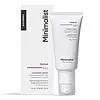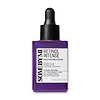What's inside
What's inside
 Key Ingredients
Key Ingredients

 Benefits
Benefits

 Concerns
Concerns

 Ingredients Side-by-side
Ingredients Side-by-side

Water
Skin ConditioningPropanediol
SolventCaprylic/Capric Triglyceride
MaskingPEG-400
Emulsion StabilisingLecithin
EmollientPropylene Glycol
HumectantArachidyl Alcohol
EmollientResveratrol
AntioxidantEthoxydiglycol
HumectantPhenoxyethanol
PreservativeBehenyl Alcohol
EmollientGlycerin
HumectantArachidyl Glucoside
EmulsifyingPolyacrylamide
Ammonium Acryloyldimethyltaurate/Beheneth-25 Methacrylate Crosspolymer
Emulsion StabilisingHydrolyzed Sodium Hyaluronate
Skin ConditioningDiisopropyl Sebacate
EmollientC13-14 Isoparaffin
EmollientRetinal
Skin ConditioningEthylhexylglycerin
Skin ConditioningTrisodium Ethylenediamine Disuccinate
Xanthan Gum
EmulsifyingLaureth-7
EmulsifyingEthylbisiminomethylguaiacol Manganese Chloride
AntioxidantSclerotium Gum
Emulsion StabilisingPullulan
Tasmannia Lanceolata Fruit/Leaf Extract
AntioxidantSodium Citrate
BufferingCitric Acid
BufferingSilica
AbrasiveTocopherol
AntioxidantHelianthus Annuus Seed Oil
EmollientWater, Propanediol, Caprylic/Capric Triglyceride, PEG-400, Lecithin, Propylene Glycol, Arachidyl Alcohol, Resveratrol, Ethoxydiglycol, Phenoxyethanol, Behenyl Alcohol, Glycerin, Arachidyl Glucoside, Polyacrylamide, Ammonium Acryloyldimethyltaurate/Beheneth-25 Methacrylate Crosspolymer, Hydrolyzed Sodium Hyaluronate, Diisopropyl Sebacate, C13-14 Isoparaffin, Retinal, Ethylhexylglycerin, Trisodium Ethylenediamine Disuccinate, Xanthan Gum, Laureth-7, Ethylbisiminomethylguaiacol Manganese Chloride, Sclerotium Gum, Pullulan, Tasmannia Lanceolata Fruit/Leaf Extract, Sodium Citrate, Citric Acid, Silica, Tocopherol, Helianthus Annuus Seed Oil
Water
Skin ConditioningCyclohexasiloxane
EmollientDicaprylyl Carbonate
EmollientGlycerin
HumectantMethylpropanediol
Solvent1,2-Hexanediol
Skin ConditioningNiacinamide
SmoothingHydrogenated Poly(C6-14 Olefin)
EmollientPanthenol
Skin ConditioningTocopheryl Acetate
AntioxidantPiper Methysticum Leaf/Root/Stem Extract
Skin ConditioningCentella Asiatica Extract
CleansingPanax Ginseng Berry Extract
Skin ConditioningGlycyrrhiza Glabra Root Extract
BleachingFicus Carica Fruit Extract
HumectantCentella Asiatica Leaf Extract
Skin ConditioningCentella Asiatica Root Extract
Skin ConditioningMelaleuca Alternifolia Leaf Extract
PerfumingArtemisia Capillaris Extract
Eclipta Prostrata Extract
Skin ConditioningMelia Azadirachta Leaf Extract
Skin ConditioningElaeis Guineensis Oil
EmollientHydrogenated Lecithin
EmulsifyingGlyceryl Stearate
EmollientBakuchiol
AntimicrobialPalmitic Acid
EmollientSodium Polyacrylate
AbsorbentStearic Acid
CleansingXanthan Gum
EmulsifyingRetinol 0.1%
Skin ConditioningAcrylates/C10-30 Alkyl Acrylate Crosspolymer
Emulsion StabilisingButylene Glycol
HumectantDipotassium Glycyrrhizate
HumectantAdenosine
Skin ConditioningTromethamine
BufferingPolyquaternium-51
Skin ConditioningBeta-Glucan
Skin ConditioningCetyl Alcohol
EmollientBHT
AntioxidantCollagen
MoisturisingMyristic Acid
CleansingBHA
AntioxidantLeuconostoc/Radish Root Ferment Filtrate
AntimicrobialTocopherol
AntioxidantBifida Ferment Lysate
Skin ConditioningCeramide NP
Skin ConditioningSaccharomyces Ferment
Skin ConditioningRetinal
Skin ConditioningAsiaticoside
AntioxidantGlyceryl Polymethacrylate
Madecassoside
AntioxidantPropylene Glycol
HumectantPolyglyceryl-10 Oleate
Skin ConditioningGlycolipids
Skin ConditioningGlycine Soja Peptide
Skin ConditioningResveratrol
AntioxidantSucrose Distearate
EmollientAsiatic Acid
Skin ConditioningMadecassic Acid
Skin ConditioningPalmitoyl Tripeptide-1
Skin ConditioningMoringa Oleifera Seed Oil
EmollientPEG-100 Stearate
Polysorbate 20
EmulsifyingParfum
MaskingEthylhexylglycerin
Skin ConditioningWater, Cyclohexasiloxane, Dicaprylyl Carbonate, Glycerin, Methylpropanediol, 1,2-Hexanediol, Niacinamide, Hydrogenated Poly(C6-14 Olefin), Panthenol, Tocopheryl Acetate, Piper Methysticum Leaf/Root/Stem Extract, Centella Asiatica Extract, Panax Ginseng Berry Extract, Glycyrrhiza Glabra Root Extract, Ficus Carica Fruit Extract, Centella Asiatica Leaf Extract, Centella Asiatica Root Extract, Melaleuca Alternifolia Leaf Extract, Artemisia Capillaris Extract, Eclipta Prostrata Extract, Melia Azadirachta Leaf Extract, Elaeis Guineensis Oil, Hydrogenated Lecithin, Glyceryl Stearate, Bakuchiol, Palmitic Acid, Sodium Polyacrylate, Stearic Acid, Xanthan Gum, Retinol 0.1%, Acrylates/C10-30 Alkyl Acrylate Crosspolymer, Butylene Glycol, Dipotassium Glycyrrhizate, Adenosine, Tromethamine, Polyquaternium-51, Beta-Glucan, Cetyl Alcohol, BHT, Collagen, Myristic Acid, BHA, Leuconostoc/Radish Root Ferment Filtrate, Tocopherol, Bifida Ferment Lysate, Ceramide NP, Saccharomyces Ferment, Retinal, Asiaticoside, Glyceryl Polymethacrylate, Madecassoside, Propylene Glycol, Polyglyceryl-10 Oleate, Glycolipids, Glycine Soja Peptide, Resveratrol, Sucrose Distearate, Asiatic Acid, Madecassic Acid, Palmitoyl Tripeptide-1, Moringa Oleifera Seed Oil, PEG-100 Stearate, Polysorbate 20, Parfum, Ethylhexylglycerin
 Reviews
Reviews

Ingredients Explained
These ingredients are found in both products.
Ingredients higher up in an ingredient list are typically present in a larger amount.
Ethylhexylglycerin (we can't pronounce this either) is commonly used as a preservative and skin softener. It is derived from glyceryl.
You might see Ethylhexylglycerin often paired with other preservatives such as phenoxyethanol. Ethylhexylglycerin has been found to increase the effectiveness of these other preservatives.
Glycerin is already naturally found in your skin. It helps moisturize and protect your skin.
A study from 2016 found glycerin to be more effective as a humectant than AHAs and hyaluronic acid.
As a humectant, it helps the skin stay hydrated by pulling moisture to your skin. The low molecular weight of glycerin allows it to pull moisture into the deeper layers of your skin.
Hydrated skin improves your skin barrier; Your skin barrier helps protect against irritants and bacteria.
Glycerin has also been found to have antimicrobial and antiviral properties. Due to these properties, glycerin is often used in wound and burn treatments.
In cosmetics, glycerin is usually derived from plants such as soybean or palm. However, it can also be sourced from animals, such as tallow or animal fat.
This ingredient is organic, colorless, odorless, and non-toxic.
Glycerin is the name for this ingredient in American English. British English uses Glycerol/Glycerine.
Learn more about GlycerinPropylene Glycol is an odorless, colorless liquid. As a humectant, it helps skin retain moisture. It also aids in delivering active ingredients.
Another role of this ingredient is preventing a product from melting or freezing. Propylene glycol also adds antimicrobrial properties to a product, elongating product lifespan.
This ingredient is considered an organic alcohol and commonly added into both cosmetics and foods.
Those with sensitive skin or conditions may develop a rash when using this ingredient.
Learn more about Propylene GlycolResveratrol is a famous emerging antioxidant. It is a good alternative for sensitive skin types who cannot tolerate retinoids.
This antioxidant is most famous for it's anti-aging benefits. Studies show it combats the signs of aging by:
Besides anti-aging, this ingredient also helps with skin brightening and soothing.
The most effective forms of resveratrol are isobutyrate and butyrate. These have the strongest effect on increasing A1 collagen and reducing inflammation.
A note on it being a retinoid alternative:
Despite it's amazing skin benefits, it is not a replacement for retinoids. However, it is recommended for people with sensitive skin or intolerance to retinoids.
Resveratrol is naturally found in grapes, peanuts, and berries.
Learn more about ResveratrolRetinal is a form of retinoid. Retinoids are the gold-standard class of anti-aging ingredients.
Retinal has many benefits as other retinoids: improve skin texture, reduce large pores, reduce the effects of aging, reduce the visibility of dark spots, heal scars, and fight acne.
Studies show retinal may work at a faster rate than retinol due to its structure.
All retinoids have to be converted into retinoic acid before starting to work. Some retinoids take several steps of conversion before binding. Retinal is only one step away, making it more potent.
Like other retinoids, retinal may be irritating. It is best to ease into using this ingredient frequently.
Using the 'ramp up' method, start by using retinol once a week. This gives your skin time to adjust and decrease irritation. Once you feel ready, you can slowly increase the frequency of retinol use.
Using retinoids will increase sun-sensitivity in the first few weeks of use. Though studies show retinoids increase your skin's natural SPF with continuous use, it is best to always wear sunscreen and sun-protection.
Learn more about RetinalTocopherol (also known as Vitamin E) is a common antioxidant used to help protect the skin from free-radicals and strengthen the skin barrier. It's also fat soluble - this means our skin is great at absorbing it.
Vitamin E also helps keep your natural skin lipids healthy. Your lipid skin barrier naturally consists of lipids, ceramides, and fatty acids. Vitamin E offers extra protection for your skin’s lipid barrier, keeping your skin healthy and nourished.
Another benefit is a bit of UV protection. Vitamin E helps reduce the damage caused by UVB rays. (It should not replace your sunscreen). Combining it with Vitamin C can decrease sunburned cells and hyperpigmentation after UV exposure.
You might have noticed Vitamin E + C often paired together. This is because it is great at stabilizing Vitamin C. Using the two together helps increase the effectiveness of both ingredients.
There are often claims that Vitamin E can reduce/prevent scarring, but these claims haven't been confirmed by scientific research.
Learn more about TocopherolWater. It's the most common cosmetic ingredient of all. You'll usually see it at the top of ingredient lists, meaning that it makes up the largest part of the product.
So why is it so popular? Water most often acts as a solvent - this means that it helps dissolve other ingredients into the formulation.
You'll also recognize water as that liquid we all need to stay alive. If you see this, drink a glass of water. Stay hydrated!
Learn more about WaterXanthan gum is used as a stabilizer and thickener within cosmetic products. It helps give products a sticky, thick feeling - preventing them from being too runny.
On the technical side of things, xanthan gum is a polysaccharide - a combination consisting of multiple sugar molecules bonded together.
Xanthan gum is a pretty common and great ingredient. It is a natural, non-toxic, non-irritating ingredient that is also commonly used in food products.
Learn more about Xanthan Gum